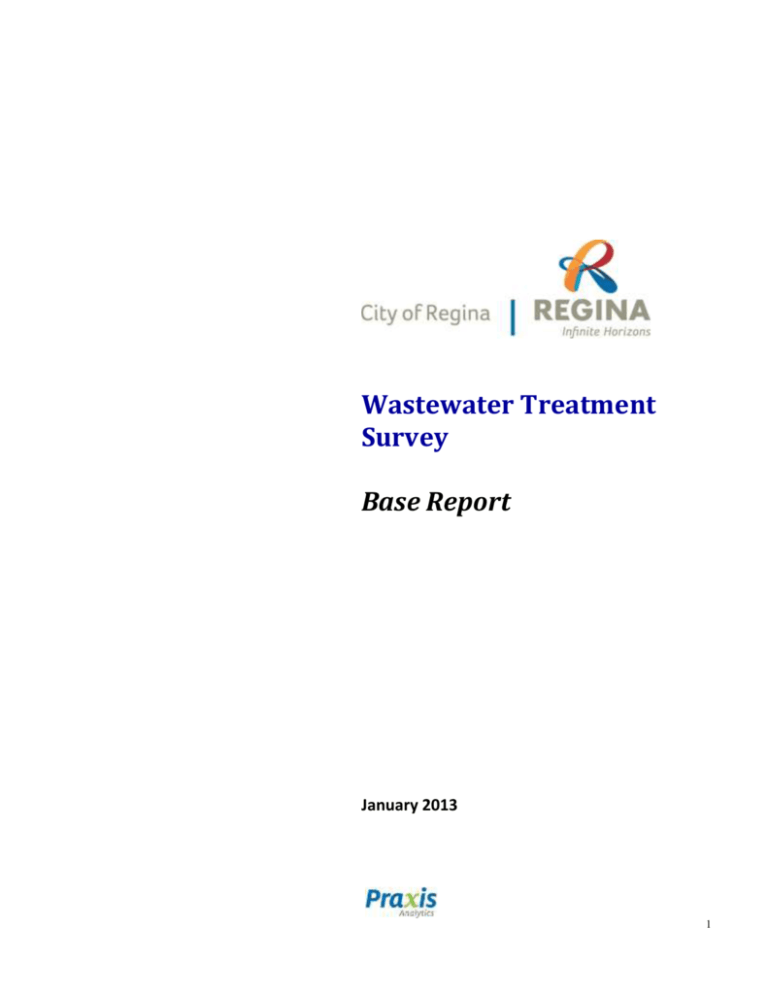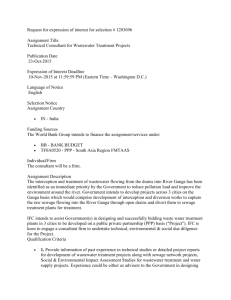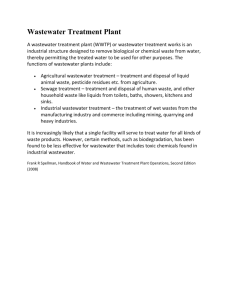Go to resource - Regina Open Government Data Catalogue
advertisement

Wastewater Treatment Survey Base Report January 2013 1 Introduction This document reports the details of a survey of residents of the City of Regina, conducted by Praxis Analytics in December 2012. Interviews were conducted with a sample of Regina residents contacted by telephone using randomlyselected numbers, or by email through Praxis Analytics online panel. Methodology Fieldwork was done December 17-21, 2012. Interviews were completed with 508 individuals. Results were weighted for age. This was a non-probability sample survey (a function of including online panel members in the sample), and thus is not subject to margins of error projections as a probability sample would be. However, a probability sample of this size in the City of Regina would yield a general margin of error of plus or minus 4.34% at the 95% confidence level. It is increasingly common to use non-probability samples and our experience does not suggest that projections from panel respondents are materially different in practical impact so long as the sample’s demographic make-up is consistent with the population. The difference is important to note nevertheless because data reported in this document is addressed in terms of the probability of difference, and therefore this caution should be kept in mind. Interpreting Results In many cases data in this survey was captured on a symmetrical, five-point response scale. This type of scale permits: Determining the extent of positive or negative response by comparing the percentage of responses on either side of the 3 midpoint. Identifying whether the response pattern is polarized, and whether strongly held opinions at either end of the scale occur more frequently than expected. A single measure for each question using the mean (average) of all responses from 1 to 5. The mean response level indicates whether the overall response pattern is positive or negative, and to make simple comparisons between questions. Mean response levels indicate the strength of response to an individual question. Strongly-held opinions are represented by either a 1 on the negative side or by a 5 on the positive side of the scale. The midpoint of the scale is 3 so, when responses are averaged, an average or neutral response would be 3.00. Mean response levels above 3.00 suggest a positive overall response while those below 3.00 suggest a negative overall response. Mean response levels of, say, 2.50 or 3.50 can be considered substantially negative or positive opinions. Mean response levels can be considered exceptionally low or high if they approach values of, say, 2.00 or 4.00, respectively. 2 Highlights Wide awareness of the wastewater plant project: Almost three quarters (73.6%) of respondents report having heard information about the wastewater treatment plant upgrade. Awareness of the wastewater upgrade lags that of the Regina Revitalization Initiative (96.3%) but approaches the level for City Square Plaza (78.9%) despite the relative newness of the wastewater project. Majority perception of the project is positive: 63% report their first reaction on hearing of the wastewater project as positive, versus only 7.6% reporting an initial negativity (the remainder, 29.5%, were neutral). The average response level is strong at 3.74, driven by the 7:1 ratio of Very Positive responses to Very Negative. Negativity is driven by concern for cost and tax implications: Among the 7.6% reporting initial negativity, by far the largest group (68.1%) indicated their reservations arise from the expense and its impact on fees or taxes. Other reasons for negative attitudes are odour or sewage problems (17%) or a view that the City has provided too little information (15%). Cost-effectiveness trumps exceeding new federal/provincial standards: By a ratio of 3:2, respondents give priority to meeting requirements cost-effectively. A strong majority (62%) feels the upgraded wastewater plant should meet the new standards as effectively as possible, but with an eye on cost. A sizeable minority (38%), however, feels the new standards should be exceeded despite additional cost. Environmental impact is a key consideration among respondents. The two top-rated factors among five tested are limiting adverse effect on people downstream (4.54 average response on the 1-5 scale), and making sure treatment limits environmental impact (4.41). An environment-related factor, minimizing sewage smell, also rated very strongly at 4.29. New revenue opportunities and civic job guarantees are also important: Both factors ranked behind environmental considerations, but still showed strongly positive ratings. Between the two, earning revenue for supplying waste water to other uses led at 3.75. Guaranteeing the jobs of City employees currently working in wastewater treatment came last but still very positive at 3.64. Comparing relative importance of five factors Positves Average (total 4+5 rating ratings) Issue Li mi t i mpa ct on peopl e downs trea m 4.54 91% Negatives (total 1+2 ratings) 3% Li mi t envi ro i mpa ct 4.41 88% 4% Mi ni mi ze s mel l 4.29 84% 4% Ea rn s econda ry revenue 3.75 60% 11% Gua ra ntee exi s ti ng jobs 3.64 58% 19% Positive/negative percentages are rounded, neutral not shown 3 Opinion is blurred on options for operating the new plant: Asked to rate three options for running the wastewater plant, results show no statistically significant difference in overall opinion (mean response levels) between the City using existing staff (3.56) and the City hiring another company (3.51). Both ratings are well into positive range, and the 5-point difference between them is not meaningful. The numbers of respondents agreeing (either strongly or at the 4 level) with each of the three options is different but not dramatically so. It ranges from a low of 49% positive for “it’s not all that important how the City operates the plant”, to a high of 58.2% for “hire another company.” While the option showing the largest absolute number of positives is “hire another company” at 58.2%, the difference is arithmetic and not statistically different from “use existing staff” at 52.5% positive The difference in average responses is driven by the negatives. They rise from 16.1% opposing “use existing staff”, to 23.8% opposing “hire another company”, to 31.1% opposing “it’s not all that important.” Comparing opinion on how to operate the plant Positves Negatives Average (total 4+5 (total 1+2 rating ratings) ratings) Option Us e exi s ti ng s ta ff 3.56 52.5% 16.1% Hi re a nother compa ny 3.51 58.2% 23.8% It's not i mporta nt 3.28 49.0% 31.1% Other queries indicate that cost-effectiveness is clearly a dominant consideration. It is the major driver of initial negativity to the project, and the choice of the majority as the factor to use in appraising the objectives the plant should seek to achieve. It is possible to conclude that the results at this query (B3) could turn on which option would prove most cost-effective. 4 Survey Findings SECTION A: AWARENESS & SOURCE A1. Have you seen, read or heard anything lately about any of the following projects in Regina? % saying ‘Yes’ A2. Was your first reaction to the information you got about the wastewater treatment plant project more negative or more positive? Pick a number on the 1-5 scale, from 1 for Very Negative, up to 5 for Very Positive. Among 73.6% having heard about the project recently 5 A2a. What is the main reason you felt negative about the information? Among those with negative attitudes towards information regarding wastewater treatment project 6 SECTION B: PERCEPTIONS & ATTITUDES B1. Please tell me how strongly you feel about the following issues involving waste water? Pick a number on the 1-5 scale, from 1 for Very Unimportant, up to 5 for Very Important. 7 B1a. Making sure the treatment process limits any environmental impact B1b. Limiting any adverse effect on people who live downstream from Regina 8 B1c. Finding ways to minimize any sewage smell in the City from the treatment plant B1d. Earning revenue from supplying processed waste water for use in things like potash mines 9 B1e. Guaranteeing the jobs of City employees who work in the existing wastewater treatment plant 10 The federal and provincial governments have changed the standards for wastewater treatment. Regina’s existing plant is old and won’t have enough capacity to meet our future needs. For these reasons, the City of Regina must replace the present plant. B2. So, thinking about the new plant we need to build, which of these two statements comes closest to how you feel about the project: 11 B3. Please tell me how strongly you agree or disagree with the following statements about how the City operates the new treatment plant. Pick a number on the 1 to 5 scale, from 1 for Strongly Disagree, up to 5 for Strongly Agree. 12 B3a. It’s important that the City handle all aspects of the project, using its existing staff to operate the plant B3b. If there are possible advantages in hiring another company to operate the plant, the City should consider doing that as long as it’s cost effective and the City retains ownership of the plant. 13 B3c. It’s not all that important how the City chooses to operate the plant, as long as it’s done right, and in a cost effective way. 14








